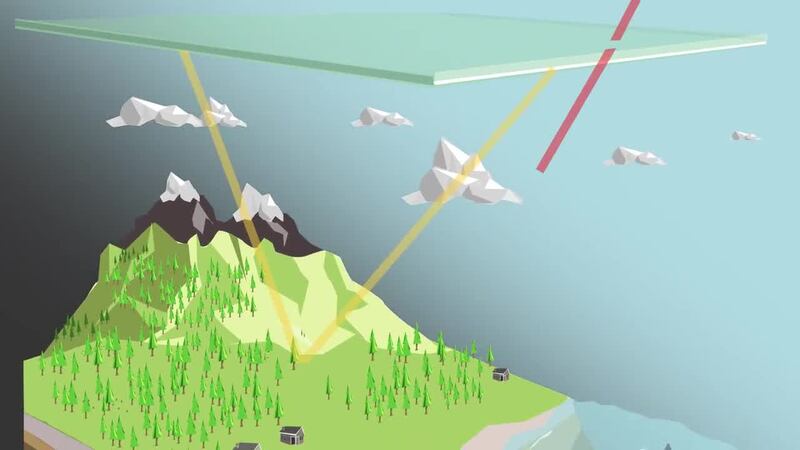Carbon dioxide levels reached the highest levels ever recorded in 800,000 years. "The State of Greenhouse Gases in the Atmosphere Based on Global Observations through 2016," the greenhouse gas bulletin released by the World Meteorological Organization, showed that the parts per million measurements surpassed the highest amount of 400 ppm established in 2015, and reached 403.3 ppm in 2016. This might seem as a small increase, but any “small” change has a huge impact in the world.
To know that this means, first we must understand what this pollutant is and how it interacts with the atmosphere and work against Earth’s health and ultimately ours.
A greenhouse gas is any gaseous compound that is capable of trapped heat in atmosphere by absorbing infrared radiation, this trapping of heat leads to the greenhouse effect.
Carbon dioxide is a greenhouse gas which has been present in the atmosphere and it is an important part of the life cycle in Earth; plants need it for photosynthesis (to grow), which then serve as food to animals and humans.
WATCH: CLIMATE AND ALLERGENS
The problem is that the amount of CO2 has increased through the years, and abruptly since the Industrial Revolution, which has caused a great unbalance in the earth’s carbon cycle. The amount of CO2 released back to the atmosphere does not balance out with the CO2 that can be processed naturally by Earth, plants, humans, etc. Larger amounts of CO2 have led to a thicker layer of this heat-trapping gas, therefore warming planet.
How do we know that CO2 levels have reached its highest levels in 800,000 years?
DENDROCHRONOLOGY
Scientists for many years have studied dendrochronology, or tree-dating. The tree growth rings are analyzed to decipher the year formed and the atmospheric conditions present during that period. Each ring shows a year and can easy show them how dry or wet it was and gasses, such as carbon dioxide were present at that time.
Scientists for many years have studied dendrochronology, or tree-dating. The tree growth rings are analyzed to decipher the year formed and the atmospheric conditions present during that period. Each ring shows a year and can easy show them how dry or wet it was and gasses, such as carbon dioxide were present at that time.
CORALS
Sort of like tree-dating, sea corals show bands each band reflects a change in temperature. A change in temperature may also reflect a change in composition of the water.
Sort of like tree-dating, sea corals show bands each band reflects a change in temperature. A change in temperature may also reflect a change in composition of the water.
ICE CORES
Deep inside ice cores, there is trapped air from many years ago. This ancient air can also be studied to measure amounts of gasses present at a certain time in history.
Deep inside ice cores, there is trapped air from many years ago. This ancient air can also be studied to measure amounts of gasses present at a certain time in history.
SEDIMENT CORES
Like tree rings, the sediment in the ocean’s floor reveals its chemistry history, think of it as like a tape recorder.
How do scientists measure emissions contributing to #ClimateChange?
— Irene Sans (@IreneSans) October 30, 2017
Lots of technology! Models that go forward in time & backwards too! pic.twitter.com/19NNtnmV1Y
Although many people may question how do we know what has happened thousands of years ago, there are many hard-working, passionate and dedicated scientists working in reverse to find out exactly how was Earth in the past. This is crucial to know where we are heading in the future and most importantly, how it could affect us.
%
%
It is important to highlight that carbon dioxide remains in the atmosphere for hundred of years in the atmosphere and much longer in oceans (CO2 makes oceans more acidic by the way), making it the most important anthropogenic long-lived greenhouse gas. It is really hard to erase or diminish CO2 levels once they are released.
%
%
So now that we know how carbon dioxide is measured, analyzed, and how it acts, let’s look how it has increased drastically since the Industrial Revolution.
The amount of CO2 remained below 280 ppm before the Industrial Revolution, 1750. Since then the amount of CO2 in the atmosphere has rapidly increased, more so during the last 150 years.
The amount of CO2 remained below 280 ppm before the Industrial Revolution, 1750. Since then the amount of CO2 in the atmosphere has rapidly increased, more so during the last 150 years.
%
%
Since the Industrial Revolution to 2016 the increase in CO2 has been of 145 percent. This increase can be broken down to different causes. The main cause is emissions from combustion of fossil fuels and from cement production, seconded by deforestation and other land use. In the last 70 years the rate of increase has been 100 times larger than at the end of the last ice age, that’s about 12,000 years ago!
%
%
WATCH MORE WEATHER FACTS AND HACKS
The earliest human fossils showed that humans lived between 6-2 million years ago.
And if you have heard that there was a period where the world was as warm or warmer than today, yes there was. That was about 3 million to 5 million years ago, when the ice sheets melted and sea level was 1-20 meters higher, but consider that during that time there weren’t many "coastal residents," populous cities, there could not have been that many humans to sustain life. The earliest humans as we know today, with the ability to walk on two legs evolved over 4 million years ago. Humans brains developed in its complexity during the past 100,000 years.
WHAT TO DO?
Along with the Paris Accord and individual regions, countries, states, and cities doing their part to limit CO2 emissions, actions must be taken right away in order to shift the trend and direction we are heading to. If not enough actions are taken, (by everyone in the world) we could reach at least 1,000 ppm by 2100. And of course, from now until then, weather events will become more extreme, as they have in recent decades.
Along with the Paris Accord and individual regions, countries, states, and cities doing their part to limit CO2 emissions, actions must be taken right away in order to shift the trend and direction we are heading to. If not enough actions are taken, (by everyone in the world) we could reach at least 1,000 ppm by 2100. And of course, from now until then, weather events will become more extreme, as they have in recent decades.
%
%
Official release by the WMO here: http://bit.ly/2ltLnZR
Cox Media Group






